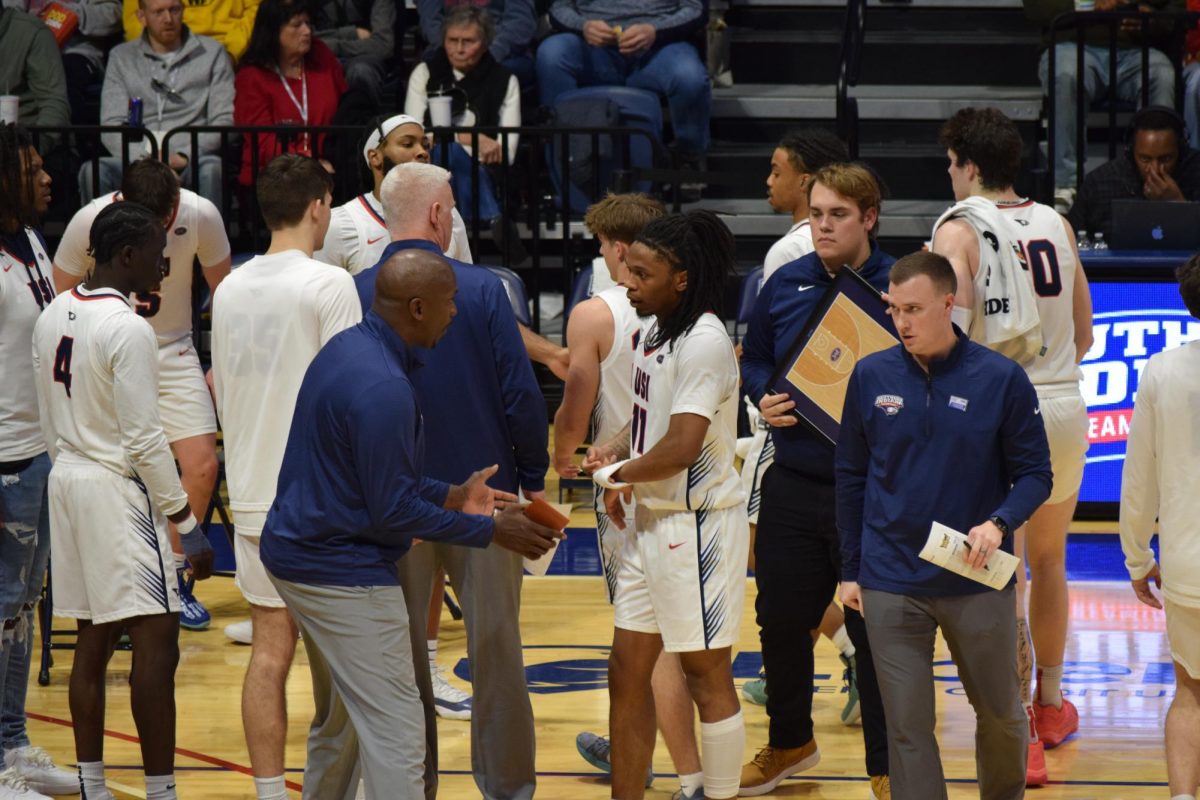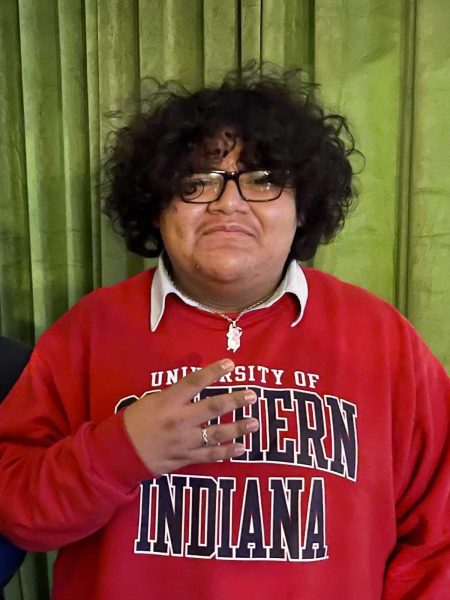It has not been a good 2025 for the men’s basketball team, to say the least. The team is 3-10 since the new year started, having now lost six in a row, and is on the verge of missing the OVC playoffs entirely. What has gone wrong with this team and why do they look completely different from earlier in the season?
The season opened on a relatively high note, as the team won excellent games against Bellarmine University, the University of South Dakota and Indiana State University.
The month of December looked as if the team was building momentum, with a close loss against a solid Southern Illinois-Carbondale team and wins against Shawnee State and Tennessee State in their conference opener.
However, that seems as if it was an eternity ago, as the team hasn’t captured the magic it had early in the season. The team has lost a semblance of what made it formidable early on: depth and versatility.
The team showed flashes of these traits early in the season. The backcourt trio of Damoni Harrison, junior guard; Jayland Randall, junior guard and Jack Campion, junior guard, played with confidence and great chemistry. Campion looked set to have his best season as the team’s point guard, as he began the season with multiple nine-plus assist games. Harrison and Randall were a duo of wings who could get buckets and play defense, something that was missing last season.
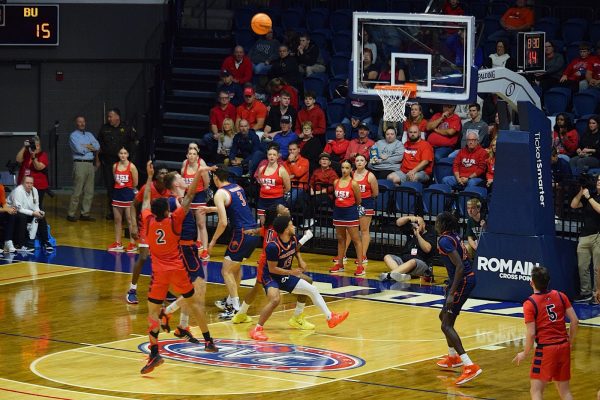
(Alex Mendoza)
Stephen Olowoniyi, sophomore forward, was the surprise factor of the season, emerging as a key defensive specialist while playing an unsung role on offense as well. His frontcourt counterpart, Jack Mielke, graduate forward, was poised for his last dance at USI and looked to continue a strong season from last year as the team’s leader and three-point specialist.
The bench was filled with strong talent, ranging from players like Sam Kodi, a junior guard—an athletic player who plays smart and can run the second unit. Braxton Jones, a three-level scorer, can step in as a facilitator when needed. Jared Washington is a three-and-D guard who plays with a next-level mentality. Alex Horiuk, junior forward/center, can be the anchor in the paint on defense and create space on offense. Finally, there’s Josiah Dunham, freshman guard, who has a high IQ and needs to be on the floor despite being a freshman—he’s an instant contributor in his first campaign.
All of this begs the question: What went wrong? A simple explanation may be best—the rotation has been cut too short and it’s having a negative impact on the team.
There’s a common theory that coaches tend to shrink the rotation as the season progresses to get the best players on the court for the maximum amount of play. Pat Riley, NBA champion head coach, has a quote about utilizing lineups as teams get close to the playoffs:
“Use eight, rotate seven, play six, trust five.”
For USI, it seems that head coach Stan Gouard only trusts four players: Harrison, Randall, Olowoniyi and Mielke. This was evident in Saturday’s game against Lindenwood—a must-win game to stay in contention for the Ohio Valley Conference tournament—where Mielke, Olowoniyi, Harrison and Randall all played 39 or more minutes.
The game did go into overtime, so additional time was needed. However, in the last five games, there have been 18 instances where these four players have played 33 or more minutes. This number is about 82% of a full game, which is 40 minutes.
Jack Campion also played more than 40 minutes in this contest, but in the past few games, his minutes have fluctuated between nine and 32 minutes. He and Sam Kodi have shared the starting point guard role for much of 2025, until Kodi sustained an injury recently that has all but named Campion as the starting point guard.
Returning to lineups, the concept of shortening the rotation has its drawbacks. Players can get burned out and may not perform at their best when logging heavy minutes for long stretches.
This can be seen in the case of Damoni Harrison, junior guard and USI’s most skilled scorer, who has averaged 36.8 minutes per contest in his last five games. He has shot below 40% from the field three times and below 30% twice on 16.8 field goal attempts per game in that span. Could this be due to opposing teams adjusting their defensive strategies? Maybe, but it’s likely a mix of both that and fatigue.
This is not to say that Harrison is an inefficient scorer, as he has been highly efficient for most of the season. He has shot 43% from the field (12 field goal attempts per game) and an excellent 40% from deep (four three-point attempts per game).
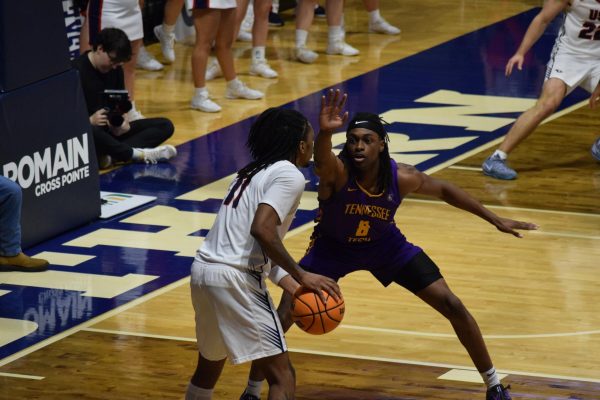
However, this isn’t just an individual player having a string of poor shooting performances—the team has failed to put together consistent performances.
In the past six games, the Eagles have shot less than 40% from the field while allowing opponents to shoot 49.6% in return. They have been outrebounded 33.7 to 29.7, and their free-throws/field goal attempt percentage sits at close to 18%, compared to their season average of 23.8%. This suggests the team is settling for jumpers rather than being aggressive, attacking the basket, and putting pressure on the opposing defense.
I have another theory as to why the team has been struggling: a lack of a fourth scoring threat.
As I stated earlier, Harrison and Randall have been a formidable scoring duo this season. In addition, Stephen Olowoniyi has been a pleasant surprise offensively, as he has a solid hook shot and the speed to use against bigger but less agile opponents. However, Olowoniyi doesn’t have a consistent jumper—something he can definitely develop in the future. If he had that, he’d likely be playing in the Big Ten Conference, competing in March. Still, he’s a solid scorer, averaging 14 points per game.
However, if you looked for a fourth scoring option, you’d have to really think. Jack Mielke hasn’t recaptured his shooting touch from last year, when he shot 40% from both the field and beyond the arc. However, he contributes in other ways, such as rebounding, communicating plays, and playing as the small-ball five when the team goes to a four-guard lineup.
Braxton Jones was thought of as one of the better scorers on the team, and he’s had flashes of brilliance, especially in December. However, his shooting as a whole has been a letdown this season and defensively, he’s a liability. He ranks last in defensive plus/minus and second to last in defensive rating per 100 possessions.
Believe it or not, the numbers actually say that Jared Washington is the answer. Washington isn’t in the rotation, for reasons I’m not quite sure of. He is third in points per 40 minutes at 20.2, third in offensive rating per 100 possessions at 111.17 (minimum of 10 games played) and fourth in offensive plus/minus at -0.7. In addition, his defensive numbers are impressive—he ranks first in defensive plus/minus at -0.3 and second in defensive rating per 100 possessions at 104.2 (minimum of 10 games played).
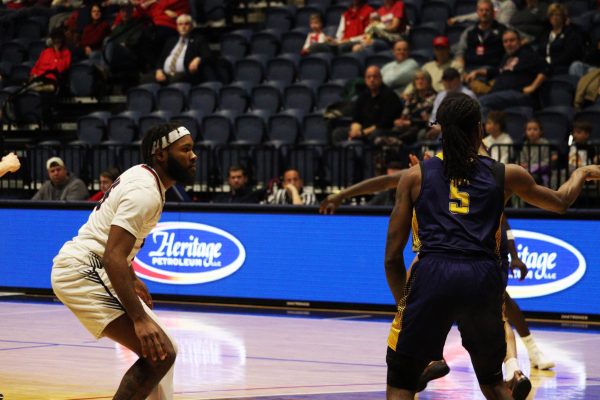
Big Picture: This isn’t just a problem with one player or a group of players. It’s not completely on Coach Gouard or any of the staff, because they aren’t the ones out there playing. The team as a whole has struggled during this stretch, and as a result, the collective is at fault for this string of losses. It’s going to take some quick but effective adjustments and a real change in the team’s mental approach to games in order to keep the season alive.
USI could still turn its season around with four games left. The team is exactly four games behind Lindenwood, Tennessee Tech, and the University of Tennessee-Martin in the standings, with all three sitting at 8-8 in conference play. The likelihood of USI winning four in a row while one of those teams loses four straight is slim—but it’s not zero percent. A lot would have to change for USI to secure a spot in the tournament.
(All stats used in the article are courtesy of Sports-Reference)


